AR Games – 5 Examples of Gamified AR Filters

Thinking about an engaging marketing strategy to connect with your customers? Gamified AR filters are the way to go. See the best examples of successful campaigns using AR games.
The main goal of a good marketing strategy is not about a quick increase in sales, but about building long-lasting relationships with customers and digital visibility. And the best way to do that is by directly involving the users in interacting with the brand. We’ve already witnessed the success of gamification – with Duolingo as the best example – and it seems that we will only see more of it in the future.
As expected, the concept of AR games was first appreciated with the Pokémon GO boom. Even now, a few years after the hype had passed, Niantic is still successfully growing its AR features. The rewarded AR ads were introduced just a few weeks ago, allowing the users the opportunity to collect unique in-game additional items and interact with the brand at the same time.
Technology Behind Gamified AR Filters
Gamified AR filters are some of the most complex experiences to create. Plane tracking, head tracking, face masks and many more are often combined with interactive 3D objects, immersing the user in high-quality entertainment.
How can the features be used? Possibilities are endless, depending on the desired goal. For example, head tracking often allows users to control the game, avoid obstacles, or collect objects to increase the score, while plane tracking makes the game a part of the real world – like with Peridot, an AR game also designed by Niantic.
What are some of our favourite examples of AR games?
Chupa Chups gaming portal
This immersive project was a result of a collaboration between Perfetti Van Melle India and Xtendr Technologies. Both brands created the first-of-its-kind Meta-ready experience, transporting users to the realm of interactive games. WebAR allows everyone to step into the digital world of Chupa Chups and take part in the candy hunt, bowling challenge, or play the unique version of the retro snake game – wherever they are!
Even though the experience was targeted in India, it reached an audience in 94 countries through organic shares with over 28% of users coming back to play the game again.
McDonald’s gamified AR mirror
Did you know that AR mirrors can do more than just fashion try-on? McDonald’s showed us how! Gamified AR mirror, created by Lens That, is a completely different experience – so we just had to mention it. As a part of the annual McDonald’s’ management conference in Poland, the brand chose this gamified AR filter as a way to bring its employees closer together. By standing in front of the mirror, users can watch as the world around them transforms into the most creative AR game. The goal? Players have to balance virtual coins on their heads for as long as possible.
by McDonald’s
Novakid AR-test for kids
Novakid is an online language-learning platform for kids, that uses all the advantages of technology to create a fun and easy learning experience. And naturally, AR is a part of it. Kids can now take a measuring interactive test to check their English level and choose the best learning program. Even more, thanks to AI, parents can’t take the test for their kids: the app automatically scans the users’ faces to confirm their age.
The experience turned out to be a success, achieving all of the intended KPIs.
Nickelodeon’s Golf at Sea
As a dedicated TV channel for kids, it’s no wonder that Nickelodeon’s marketing strategy involves media most known to their audience. The brand joined forces with Carnival Cruise Line to create an immersive AR game, celebrating the brand’s inaugural Golf event. Now all smartphone users can play with their real-life surroundings, and take part in the famous Slime Cup.
Yves Saint Laurent Beauty Night
Even luxury brands, like Yves Saint Laurent, are fearless in joining the AR marketing world. YSL Beauty – owned by L’Oréal – created an interactive experience to promote the Black Opium perfume collection. The gamified AR filter was dedicated mainly to the new, younger audiences, already known for being a generation of digital nomads. The AR Game, designed by the BUSTERWOOD studio is still available for users all over the world, reaching new crowds every day.
by @busterwood_studio
AR Games as The Marketing of The Future?
To be successful in their communication, brands have to match the medium to the targeted audience. The youngest generation is greatly influenced by the digital world, especially with interactive features and naturally, AR seems to be the perfect way to communicate with them.
Even the latest statistics are showing the potential that lies with AR marketing: 61% of users confirmed that they prefer interacting with retailers who use Augmented Reality. It sounds promising, especially as the feature already guarantees a 40% conversion rate. And what’s a better way to build a strong relationship with the customers than through engaging AR games?
Are you thinking about grasping the marketing potential of AR but don’t know where to start? Contact us – we’re here to help!
